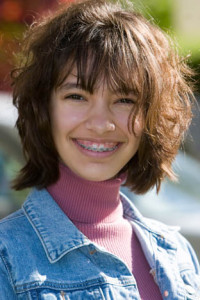It’s a question many parents struggle with. Dr. Keri Barrow, of Horner Barrow Orthodontics, in Sioux Falls, SD, has the answer to this common question.
More often than many parents realize, getting braces isn’t always a necessity, and orthodontic treatment isn’t always for the sole purpose of straightening your child’s teeth. There are other dental issues or potential problems that could cause the need for braces to minimize or eliminate these situations completely. And, when braces are deemed a possibility, some research suggests that it may be better to wait until your child is in their early teens to begin treatment options.
Overcrowded Teeth
Braces can help with straightening and separating overcrowded teeth, which makes cleaning them easier. In some cases, this type of malocclusion can also be painful, so correcting it can additionally ease your child’s pain or discomfort.
Open Bite
This dental condition occurs when the top and bottom front teeth do not completely come together when your child bites down. Both rows of teeth will continue to grow toward each other as your child gets older, so you would want to wait until all your child’s baby teeth have been replaced with their permanent teeth before taking a look at correction options for this condition.
Overbite
According to many renowned orthodontists, approximately 25 to 30 percent of children have this type of dental malocclusion. This issue cannot be corrected with braces. It is an abnormality of the skull and is treated with external options that realign your child’s jaw. Many orthodontists have determined that treating this issue at a very young age (under 8 years old) produces an positive outcome that is identical to the results when your child is treated in their teens or older.
Debilitating Issues
Some dental issues cause serious problems, such as preventing your child from being able to easily or properly eat their food, or causing a lot of pain and discomfort. In these situations, you would want to consider treatment options promptly.
Cosmetic Treatment
Many times, the most common reason for getting braces for your child is simply cosmetic; he or she feels self-conscious about the way their teeth look. Correcting that issue can greatly improve your child’s self-esteem. Crooked or disfiguring dental issues can have a big impact on your child’s future, causing problems and difficulties for them in school, in relationships, and in finding jobs later in life. Self-esteem is a really big deal, especially in younger people. If your child does have this type of dental issue, you should give serious consideration to orthodontic treatment options to give your child peace of mind, improve their sense of self-worth, and ensure that they have the best possible opportunity for success in their academic, professional, and personal lives.
If you are considering braces for your child and are concerned about the cost, ask about payment plans or financing options. There are also dental plans available outside what may be offered by your family’s health insurance that can help alleviate some of the costs associated with having orthodontic work performed on your child.
A key thing to keep in mind when braces are recommended for your child: ask the dentist why they are recommending braces and remember, it is just a recommendation, in most cases, (excluding those where your child is experiencing eating difficulties or pain/discomfort). Braces aren’t exclusively for younger kids these days, and a decision to wait until your child is older (when possible) does not mean you’re being an irresponsible parent; just a cautious, concerned, well-informed one.
At Horner Barrow Orthodontics, Dr. Kevin Horner, Dr. Keri Barrow, and the entire staff are committed to delivering excellent quality orthodontic treatment to each and every one of our patients. To provide a friendly, caring, and pleasant atmosphere that will ensure our patients feel relaxed and confident about placing their orthodontic care in our hands.
